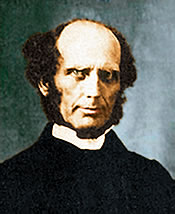 Charles Finney had a definitively non-Calvinistic view of how the atonement of Christ worked to take care of the sin problem in man. For the record, I believe he has provided a great corrective to the usual explanation. We have to begin with certain questions.
Charles Finney had a definitively non-Calvinistic view of how the atonement of Christ worked to take care of the sin problem in man. For the record, I believe he has provided a great corrective to the usual explanation. We have to begin with certain questions.
What does God, the governor, do when people who break His law and are bound for eternal punishment are truly sorry for their disobedience? Can He simply say that their sorrow is sufficient and He will negate the consequences of the broken law? If He winks at their disobedience and allows them eternal life, what is He saying about the value of His law? If He sets aside the penalties, and exercises mercy instead, might not He send a wrong message? Might not His subjects begin to believe they can ignore His law and receive mercy regardless?
Whenever someone breaks the moral law, he has invaded the rights of others; penalties are expected. God, who is righteous and just, and who has the highest good of all His subjects in mind, cannot simply ignore His own laws and overlook the consequences of sin on the community.
Finney, in showing how the atonement of Christ works to free men from their sins, approaches the doctrine from a truly governmental view, explaining it from the perspective of public justice, which, he says,
consists in the promotion and protection of the public interests, . . . as is demanded by the highest good of the public. It implies the execution of penalties of law where the precept is violated, unless something else is done that will as effectually secure the public interests [emphasis mine]. When this is done, public justice demands that the execution of the penalty shall be dispensed with by extending pardon to the criminal. Retributive justice makes no exceptions, but punishes without mercy in every instance of crime. Public justice makes exceptions, as often as this is permitted or required by the public good.
 Finney believed that the substitutionary death of Christ effectually secured public justice: it showed that God respected His own law and that sin brings consequences; it revealed the character of God, not only in His righteousness, but also in His mercy; and it was sufficient to humble men and lead them to sincere repentance and future obedience. Indeed, Finney felt that the atonement produced “a more efficient preventive of sin, and a more powerful persuasive to holiness, than the infliction of the legal penalty” would have done.
Finney believed that the substitutionary death of Christ effectually secured public justice: it showed that God respected His own law and that sin brings consequences; it revealed the character of God, not only in His righteousness, but also in His mercy; and it was sufficient to humble men and lead them to sincere repentance and future obedience. Indeed, Finney felt that the atonement produced “a more efficient preventive of sin, and a more powerful persuasive to holiness, than the infliction of the legal penalty” would have done.
Christ’s death, then, allows God the Father to show mercy to sinners who are genuinely repentant over their sinfulness. By substituting Jesus’ suffering for the penalty that should have been carried out on sinners, God has demonstrated to the world that sin is awful [Jesus died for sins], that His law must be upheld, yet He can justly forgive the penitents who will now be humbled by what Jesus has done for them, and who will seek to obey God and please Him the rest of their lives. The public will have little to fear from people who now walk in newness of life.
I love this explanation, which transforms a typical explanation of the atonement from some kind of official and sterile “transaction of a payment of debt” into a heartfelt forgiveness based on Jesus’ personal suffering and a sinner’s changed life. Many theologians portrayed the atonement in this way earlier in Christian history, but few do today. I think we need to return to this dramatic and dynamic understanding of the most significant event in human history.
